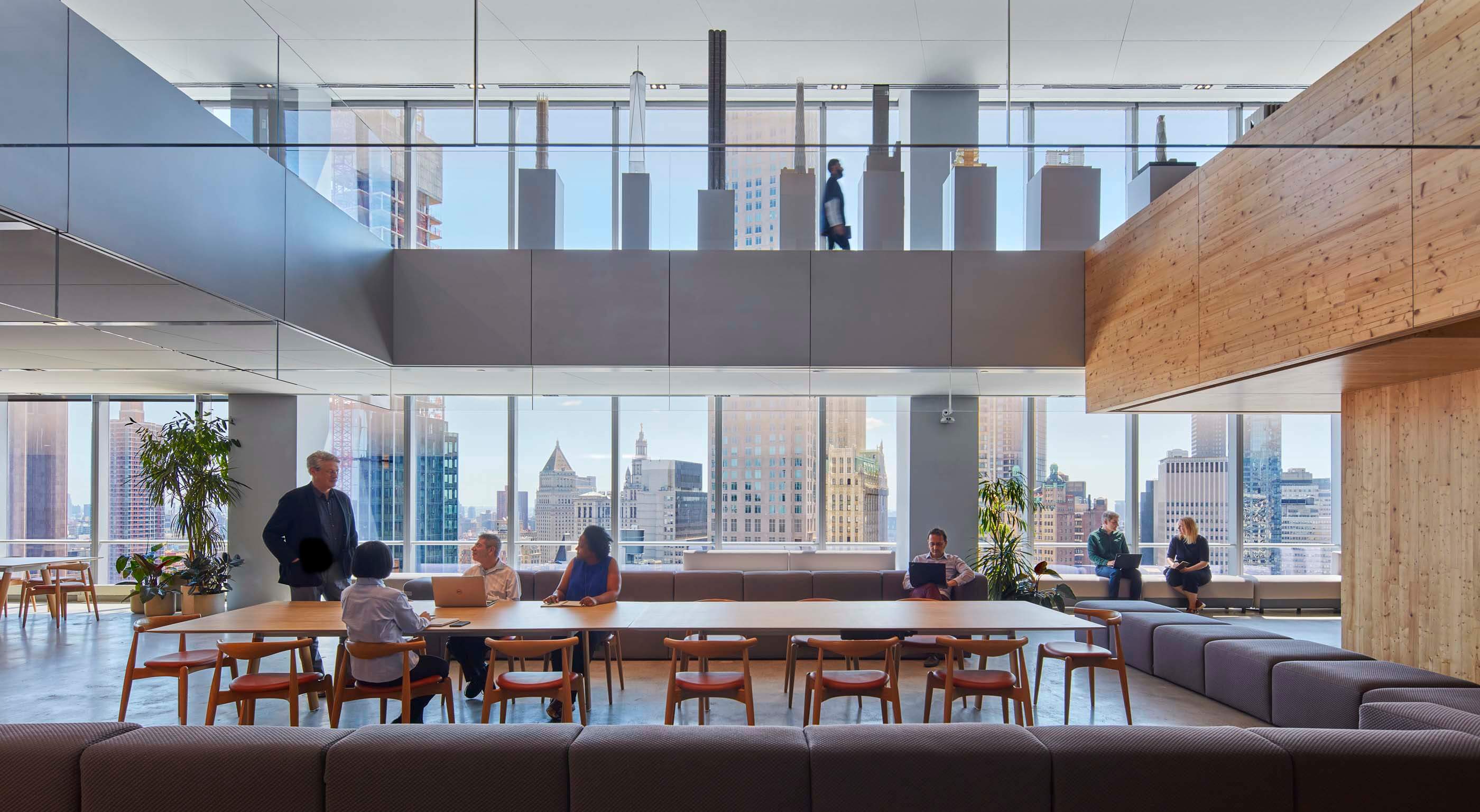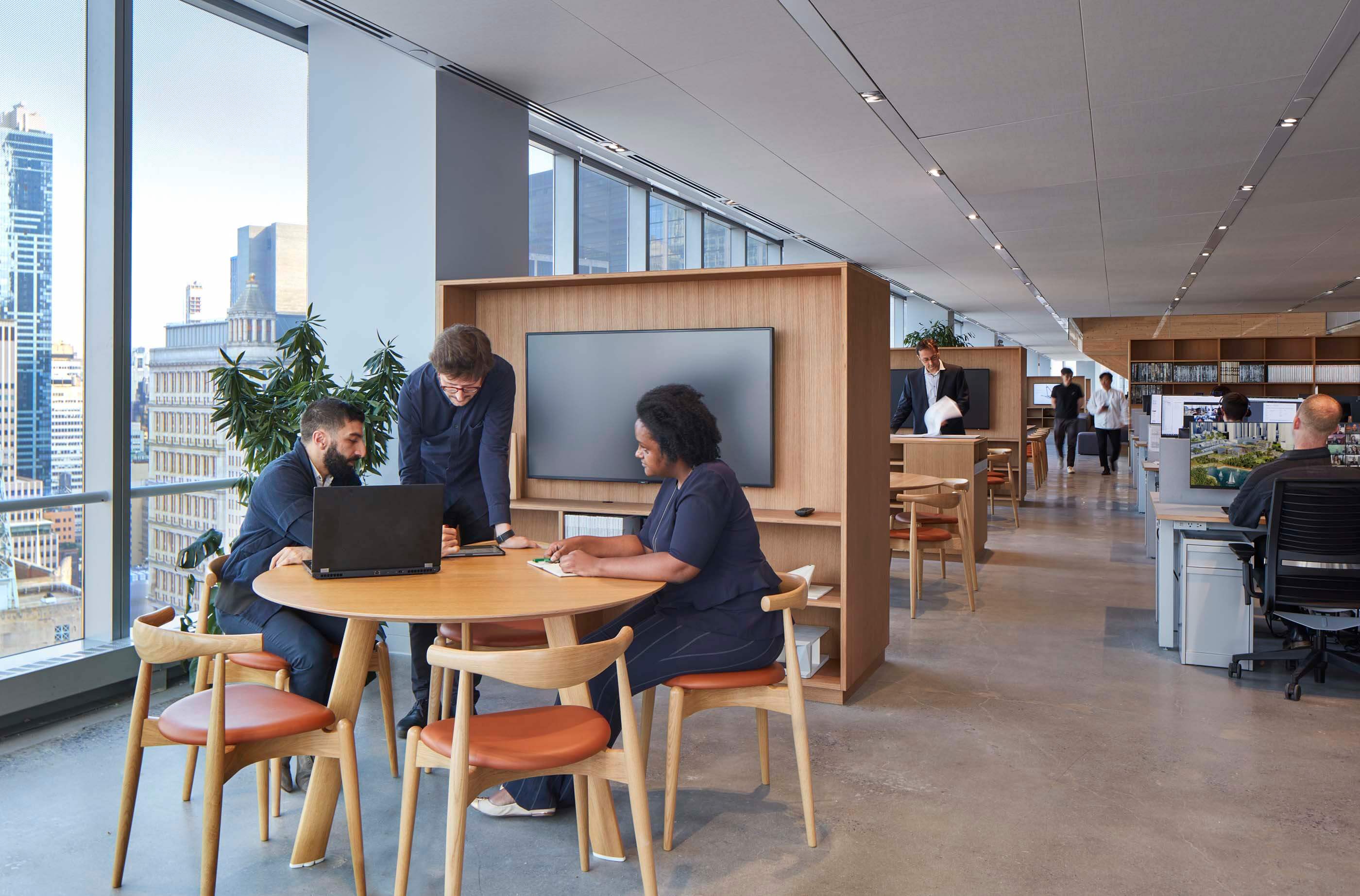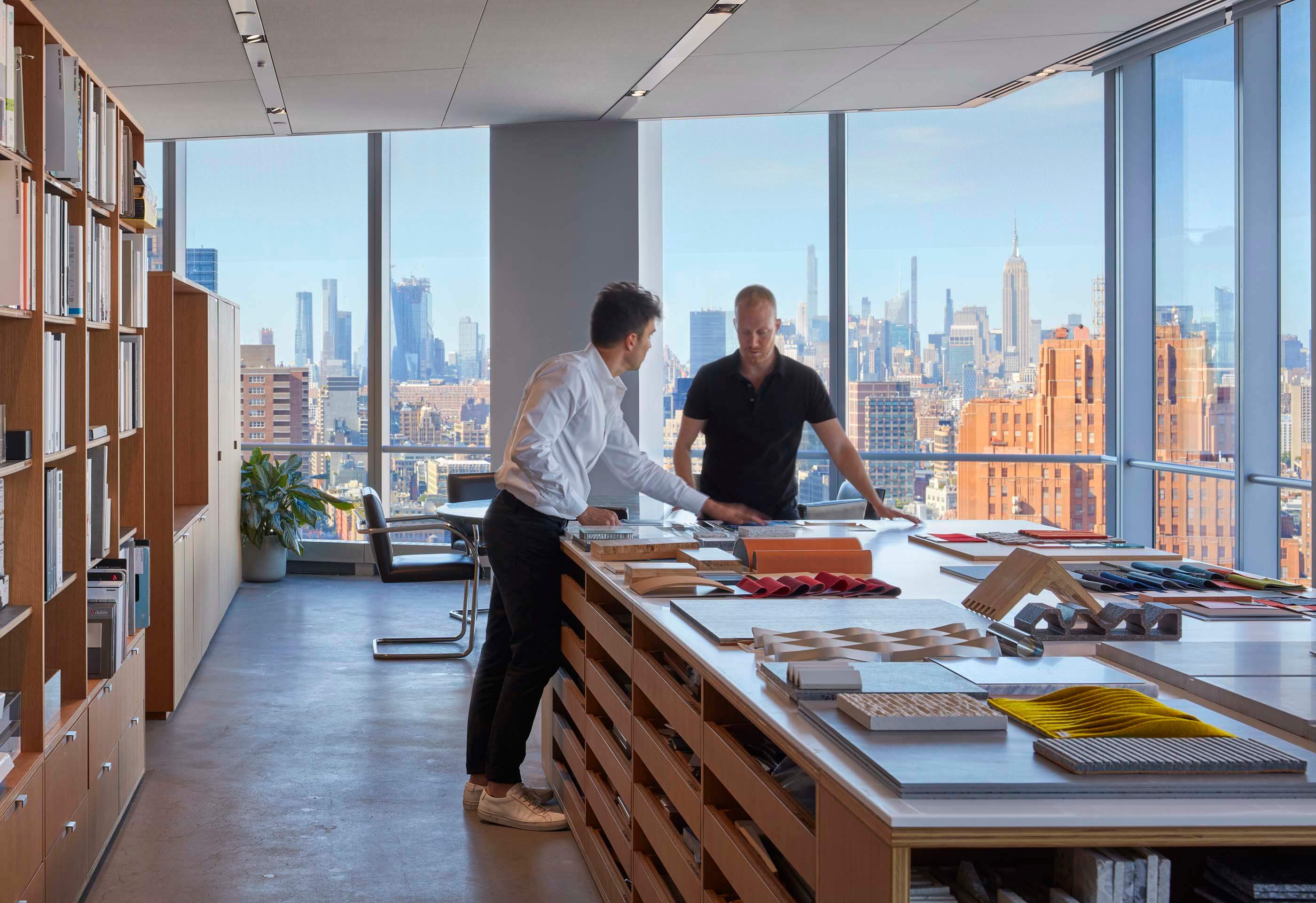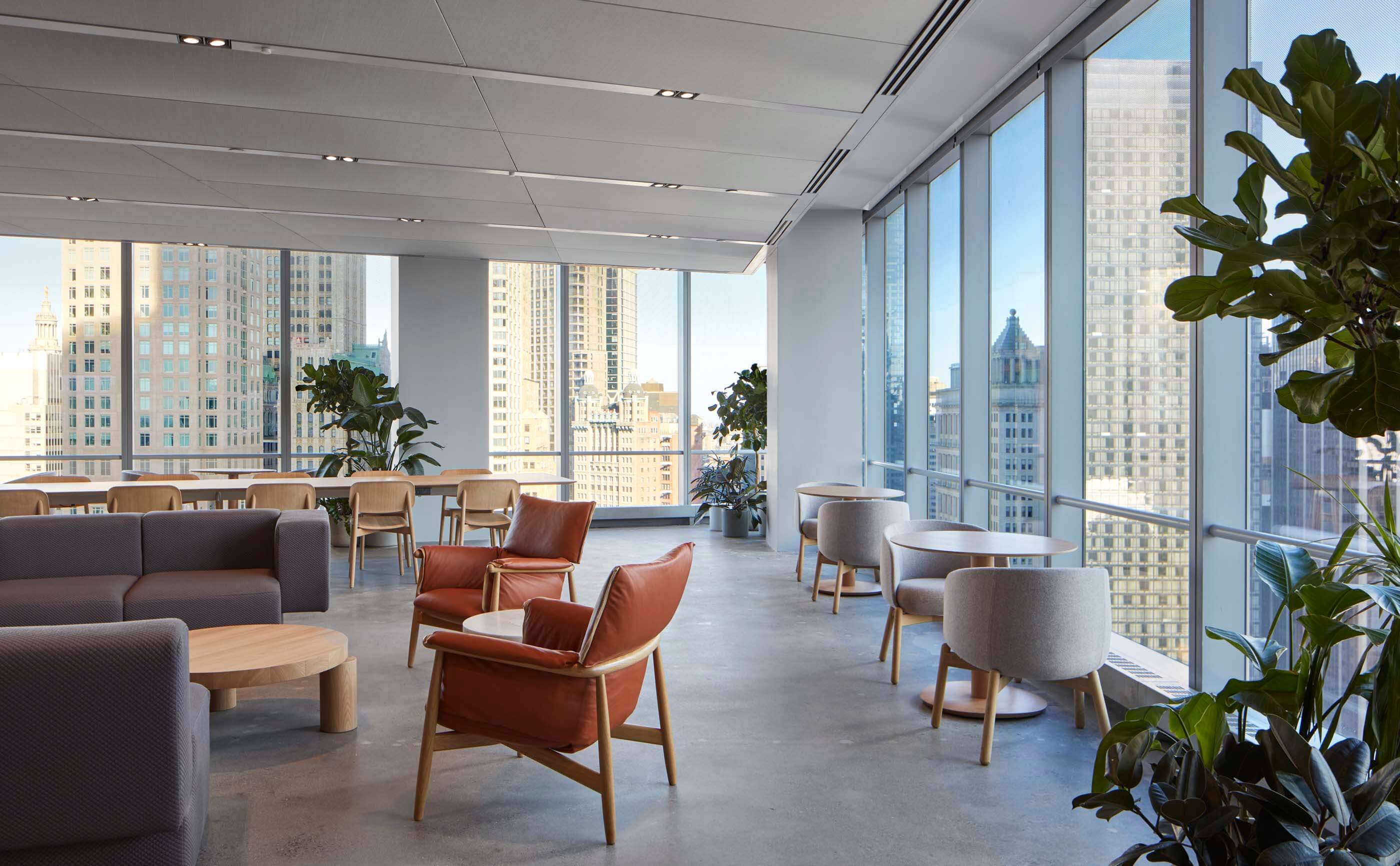
SOM’s new office adopts a philosophy of “radical reduction”
The design of a firm’s architectural office makes a statement about the values of the practice: let the mess hang out or put on a monastic show? For their new office on the 27th and 28th floors of 7 World Trade Center (WTC), Skidmore, Owings & Merrill (SOM) adopted a “radical reduction” philosophy: their space sports a concrete floor, cork-lined walls, an impressive acoustic ceiling and a cross-laminated timber (CLT) staircase. The materials contribute to a contemporary office design that seeks to eliminate excess and reduce energy consumption while maximizing comfort and flexibility. The goal for the new interior “was to holistically integrate programmatic requirements and distinct architectural features into a refined and tranquil interior,” said Chris Cooper, Partner at SOM, who led both the office redesign and the design of the 52-story 7 WTC. . (Completed in 2006, it was the first tower built on the WTC campus since 9/11.) “The result is a piece of industrial design in itself: an expansive and flexible space characterized by healthy materials, a responsible approach to the use of resources, and a focus on sustainable design and well-being.
The 28th floor elevator lobby entrance opens east to an open and spacious reception area. A large cut in the floor plate overlooks a main conference area below, and the two levels are connected by a CLT staircase inserted into this double-height space. What were once the amenities typically found in an area at the back of the house are brought to the fore. To the left of the reception area, the company’s extensive materials library is housed in a group of wooden shelves or under a counter work surface. On the right, the pantry, where the architects hydrate and caffeinate. The area surrounding the kitchen is generously furnished with cushioned benches and comfortable chairs arranged around tables for colleagues to chat over coffee or take a Zoom call.
A multitude of potted plants of all sizes are scattered here and on the floors; the office employs an outside horticultural company to look after them, with plant sitters visiting once or twice a week. The floor-to-ceiling curtain wall allows maximum sunlight for tropical shrubs and vines to enjoy impressive city views. Cooper said the glass “allows our designers, engineers and planners to immerse themselves in a city they are helping to shape and see projects from our past, present and future in all directions.”
While the 1,200-person company was founded in Chicago and has offices around the world, this is its largest office: it’s home to 422 employees, or about 35% of the entire company. . On the western part of a floor, SOM has retained layouts that could be considered traditional for the standard architectural office: clustered offices, conference rooms for pin-ups and a manufacturing workshop (although hidden behind closed doors inside the floor). Organizing the configuration of a few hundred offices was a feat of urban planning; the resulting layout organized the offices into “neighbourhoods” with huddle spaces and interspersed private spaces, including breakout areas with monitors staged against the exterior glass, useful for each project team as they collaborate. Charles Harris, Partner Architect at SOM, said they “have embraced the concept of ‘working beyond the office’ by providing a variety of workspaces and using cloud-based technology to help our staff work from anywhere in the office”.

“Flexibility” and “comfort” are the catchphrases of the post-COVID office design lexicon, but the terms were already in effect when the SOM office designed this office before the pandemic. The project was largely complete by March 2020, but the pandemic meant employees didn’t start working from space until January 2023. The design proved prophetic – with a multitude of workstations, of modules, bedrooms and living rooms, the office offers a variety of environments for working alone or together, in person or remotely. The pandemic has accelerated SOM’s efforts to work “in the cloud”: Cooper said one of the biggest impacts of the era is “the ability to harness cross-office collaboration, leverage SOM’s depth of global expertise in its offices in the United States and abroad. Although our offices have always collaborated, the ability to work together digitally with cloud-based technology has helped make this collaboration even more seamless and efficient. »
At SOM, there is a rush of activity in the office on Tuesdays which then decreases the rest of the week. Despite decent occupancy, on a recent visit Thursday morning the telltale cacophony of mouse and keyboard clicks is absent as most of the sound is absorbed by the ceiling, which has a high STC rating. Lighting and HVAC distribution are executed in long linear strips that follow the parallelogram plan of the building, leaving the rest of the surface gray for absorption. Sound is also a priority in conference rooms, which feature cork-covered walls and floors and additional curtains as an acoustic buffer.

Visual comfort is also important: Cooper said he avoided gloss white paint, opting instead for a range of grays and wood tones to avoid eye strain and glare. Similarly, Harris explained that the office uses “an array of daylight sensors that react to the position of the sun to maximize natural lighting and reduce artificial light to the smallest possible level,” which contributed to a illumination power density more than 50% lower than average. offices and a 25% reduction in planned operational energy consumption. The abundance of daylight was a refreshing change from SOM’s former office in the Bankers Trust Building at 14 Wall Street, a formidable masonry-clad skyscraper where sunlight was much scarcer.
Harris also shared that the desk was “one of the first projects where we comprehensively calculated the embodied carbon of each material because we wanted to measure our embodied carbon footprint.” Carbon was the main consideration, but it was balanced with acoustics, durability and functionality. Their work shows a 22% reduction in embodied carbon in typical offices.


The office anticipated the living comforts that work environments need as the pandemic slowly recedes, but in a broader sense, the interior points to a direction for SOM’s future. It’s technical, of course, but both environmentally sensitive and materially rich. “I think what this office represents, historically, is the last stage in the evolution of SOM,” Cooper said. “SOM was founded in 1936, and to thrive for 87 years, you must continually modernize and adapt.” Cooper said they believe “the design of a workplace has the power to shape the culture of an organization”.
SOM’s New York office is backed by “decades of research, experimentation and first-hand experience,” Cooper said. “It’s built around the culture we would like to create – as a flexible and sustainable workplace that helps build community, improves well-being and accommodates different working styles to bring out the best in everyone. .”

Comments are closed.